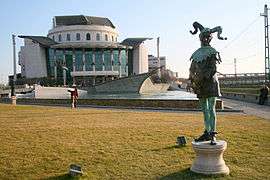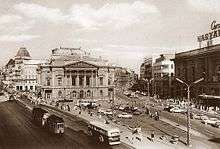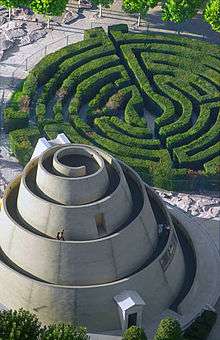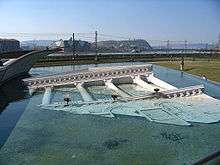National Theatre (Budapest)
 | |
| Address | Bajor Gizi park 1. |
|---|---|
| Location | Budapest, Hungary |
| Coordinates | 47°28′15.89″N 19°4′14.04″E / 47.4710806°N 19.0705667°E |
| Type | Theatre, Performing arts center |
| Capacity | 619 |
| Construction | |
| Built | 2002 |
| Opened | (1837) 2002 |
| Website | |
|
www | |
The National Theatre is the main theatre of Budapest, opening originally in 1837. Its company used several locations since then, including the original building at the Kerepesi Street, the People's Theatre at the Blaha Lujza Square and their longest temporary home was at Hevesi Sándor Square. Their permanent, current home, the new National Theatre opened on 15 March 2002.
History


The idea of a national theatre in the capital was formed around the turn of the 18th-19th century, promoted by several great thinkers, including Ferenc Kazinczy. Baron István Széchenyi, a major figure in the reform age of Hungary dreamed of a great building on the bank of the Danube, operated in the form of a joint stock company. He proposed his plans in his 1832 pamphlet A Magyar Játékszínről.
However, the realization was difficult, as factions could not decide on the basic conception. Some proposed a simpler institution, open for the wide masses, and some wanted a closed, elite institution for the aristocracy.
The Hungarian Parliament made the decision in his 41st article of 1836, and led by Antal Grassalkovich, the construction began in 1835 on the Kerepesi Street. With a company assembled in the previous 4 years by András Fáy and Gábor Döbrentei (playing in the Court Theatre of Buda), the theatre opened on August 22, 1837 under the name Pesti Magyar Színház (Hungarian Theatre of Pest). Its goals were to give birth to the national drama, and to showcase classics of world literature. Nationalized in 1840, the name was changed to National Theatre.
The National Theatre was demolished in the 1900s. The company moved to the People's Theatre at Blaha Lujza Square in 1908. The company was just the tenant of People's Theatre in the following decades while the building's state continually deteriorated. Then in 1963 authorities decided to demolish, citing metro line construction as the reason. Operation ceased one year later, and the building was blown up on April 23, 1965. The company was transferred to the renovated Petőfi Theatre (today known as Thália), in the Nagymező Street, and two years later to the former Magyar Theatre in the Hevesi Sándor Square.

After the demolition of the People's Theatre a proposal was made to build the new theater in the City Park, at the Felvonulási Square. An international tender was held in 1965, but no first prizes were given. The second prize was shared between plans of Miklós Hofer and Jan Boguslawski - Bogdan Gniewiewski. The next two decades dragged on with the planning at the Company for Public Building Planning led by Miklós Hofer. The building permit was finally given in 1985, but the construction went no further than chopping out a few trees. In 1988 a tender was held for a new location and the Engels (today Erzsébet) Square was chosen. A decade passed without any progress. In 1996 the parliament finally agreed to move on the next phase, but the project became severely entangled by political quarrels in the next few years. After tendering the plans (won by Ferenc Bán), the construction began in 1998, but the new government elected in the same year stopped the work, finding it too costly.
In 1999 ministry commissioner György Schwajda entrusted Mária Siklós to make plans for a building at a new location,[1] the bank of the Danube, but following the rage of the architect scene, a tender was held, resulting in György Vadász's victory. As he was not willing to tailor Siklós's plans any further,[2] the construction began with her plans on September 14, 2000. The new National Theatre opened on the National holiday, March 15, 2002.
The new National Theatre

The building lies on the bank of the Danube, in the Ferencváros district, between the Soroksári road, the Grand Boulevard and the Lágymányosi Bridge, and is a five-minute walk from the Csepel HÉV. The area of the theatre, along with an open-air stage is 20 844 square meters, and can be functionally separated into three parts. The central part is the nearly round building of the auditorium and stage, surrounded by corridors and public areas. The second is the U-shaped industrial section around the main stage. The third section is the park that surrounds the area, containing numerous memorials commemorating the Hungarian drama and film industry. The nearby Palace of Arts was opened in 2005.
György Schwajda became the first director of the theater. He signed the "company's core" and he founded the title Actor of nation with a financial reward, but he resigned in the summer of 2002. Then Peter Huszti without tender called by the minister, who resigned from the professional, broad antipathy quickly. Thomas Jordan has been the head of the theater by tender. He organized the public from the countryside, and in the theater debuted the country's countys. Between 2008-2012 Robert Alföldi was led the theater. He was a divisive personality, he opposed the nation-rearing, folk theater direction. In 2013 Attila Vidnyanszky misses an opportunity in the lead of National Theater.
Footnotes
- ↑ "New quarrels around the National Theatre". Hetek.hu (in Hungarian). 1999-03-06. Retrieved 2009-10-11.
- ↑ "György Vadász will likely quit from designing the National Theatre". Origo (in Hungarian). 2000-07-03. Retrieved 2009-10-11.
References
- National Theatre in the Hungarian Theatrical Lexicon (György, Székely. Magyar Színházművészeti Lexikon. Budapest: Akadémiai Kiadó, 1994. ISBN 978-963-05-6635-3), freely available on mek.oszk.hu (hu)
- László, Kósa. A cultural history of Hungary. Budapest: Osiris Kiadó, 1998. ISBN 978-963-13-4836-1
- Nemzetiszinhaz.hu article - A brief article at the building, the garden, and a historical overviewthe on the official home page (en)
- Sulinet.hu article - An article on the history of the building on Sulinet.hu (hu)
- Index.hu article - An article detailing the demolition of the People's Theatre in 1965 (hu)
- szinhaz.hu article - - An article on the history of the National Theatre before 2002 (hu)
- magyarnarancs.hu article - An article on the history of the National Theatre between 2002-2012 (hu)
External links
| Wikimedia Commons has media related to National Theatre (Budapest). |
- Official home page of the National Theatre (en)
- Anniversaries – Self-Portraits - The National Theatre National Relic Exhibition Hall, February 1, 2008 – March 18, 2008 (en)
- Music and Musical Genres on the Pre-Erkel Hungarian Stage (.rtf) (en)
- Csatolna.hu gallery - A gallery of images of the new National Theatre
- Aerila photographs of the Theatre
